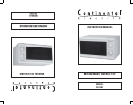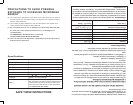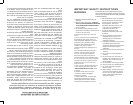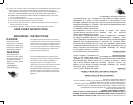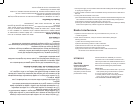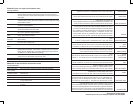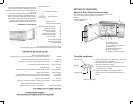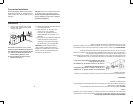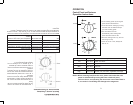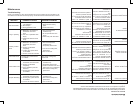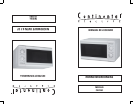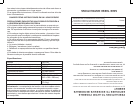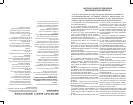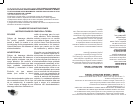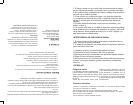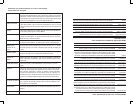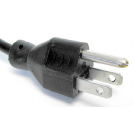
44
i) Do not overheat the liquid.
ii) Stir the liquid both before and halfway through heating it.
iii) Do not use straight-sided containers with narrow necks.
iv) After heating, allow the container to stand in the microwave oven for a short time
before removing the container.
v) Use extreme care when inserting a spoon or other utensil into the container.
19. Liquids, such as water, coffee, or tea are able to be overheated beyond the boiling point
without appearing to be boiling. Visible bubbling or boiling when the container is
removed from the microwave oven is not always present. THIS COULD RESULT IN
VERY HOT LIQUIDS SUDDENLY BOILING OVER WHEN THE CONTAINER IS
DISTURBED OR A SPOON OR OTHER UTENSIL IS INSERTED INTO THE LIQUID.
This appliance must be grounded. In the event of
an electrical short circuit, grounding reduces the risk
of electric shock by providing an escape wire for the
electric current. This appliance is equipped with a
cord having grounding wire with a grounding plug.
The plug must be plugged into an outlet that is
properly installed and grounded.
Consult a qualified electrician or serviceman if the
grounding instructions are not completely understood
or if doubt exists as to whether the appliance is
properly grounded. If it is necessary to use an
extension cord, use only a 3-wire extension cord that
has a 3-pronged grounding plug, and a 3-slot
receptacle that will accept the plug on the appliance.
GROUNDING INSTRUCTIONS
SAVE THESE INSTRUCTIONS
WARNING
DANGER
Electric Shock Hazard
Touching some of the internal
components can cause serious
personal injury or death. Do not
disassemble this appliance.
Electric Shock Hazard
Improper use of the grounding
can result in electric shock. Do
not plug into an outlet until
appliance is properly installed
and grounded.
(grounding) plug
Three-pronged
The marked rating of the extension cord shall be
equal to or greater than the electrical rating of the
appliance.
no de microondas no siempre está presente. ESTO PODRÍA OCASIONAR QUE
UN LÍQUIDO CALIENTE REPENTINAMENTE ROMPA EL HERVOR AL MOMEN-
TO DE ACCIONAR ALGÚN MOVIMIENTO O METER UNA CUCHARA U OTRO
UTENSILIO DENTRO DEL LÍQUIDO.
i) No sobrecaliente los líquidos.
ii) Remueva el líquido antes y a la mitad del proceso de calentamiento.
iii) No utilice envases o recipientes de lados verticales con cuellos angostos.
iv) Después de calentar, deje que el envase o recipiente repose dentro del horno
a microondas durante un periodo corto antes de retirarlo.
v) Tenga sumo cuidado al momento de insertar una cuchara o cualquier otro uten-
silio dentro del envase o recipiente.
GUARDE ESTAS INSTRUCCIONES
INSTRUCCIONES DE CONEXIÓN A TIERRA
PELIGRO
Peligro de descarga eléctrica
Se podría producir lesiones
serias o hasta la muerte si se
toca algunos de los componentes
internos del horno. No desarme el
electrodoméstico.
ADVERTENCIA
Peligro de descarga eléctrica
El uso inadecuado del sistema a
tierra podría ocasionar una des-
carga eléctrica. No enchufe el
electrodoméstico hasta que éste
haya quedado correctamente
instalado y conectado a tierra.
Enchufe de tres extremi-
dades (con salida a tierra)
Este electrodoméstico debe que-
dar conectado a tierra. En el caso
de un cortocircuito, la conexión
a tierra reduce el riesgo de una
descarga eléctrica ofreciendo un
cable de escape para la corri-
ente eléctrica. Este electrodo-
méstico cuenta con un cordón
con cable de tierra y con un en-
chufe a tierra. Este tipo enchufe
debe conectarse a un tomacor-
riente que cuente con la debi-
da instalación y salida a tierra.
Consulte con un electricista cali-
cado o un técnico sobre las in-
strucciones de conexión a tierra
si no las comprende totalmente o
si tuviera alguna duda de que su
electrodoméstico haya quedado
correctamente conectado a tier-
ra. Si fuera necesario utilizar un
cable de extensión, utilice un ca-
ble de tres alambres que cuente
con un enchufe de tres extremi-
dades y con un receptáculo de
tres ranuras donde se pueda co-
nectar el enchufe del electrodo-
méstico. La resistencia eléctrica
del cable de extensión debe ser
igual o mayor a la resistencia
eléctrica del electrodoméstico.



